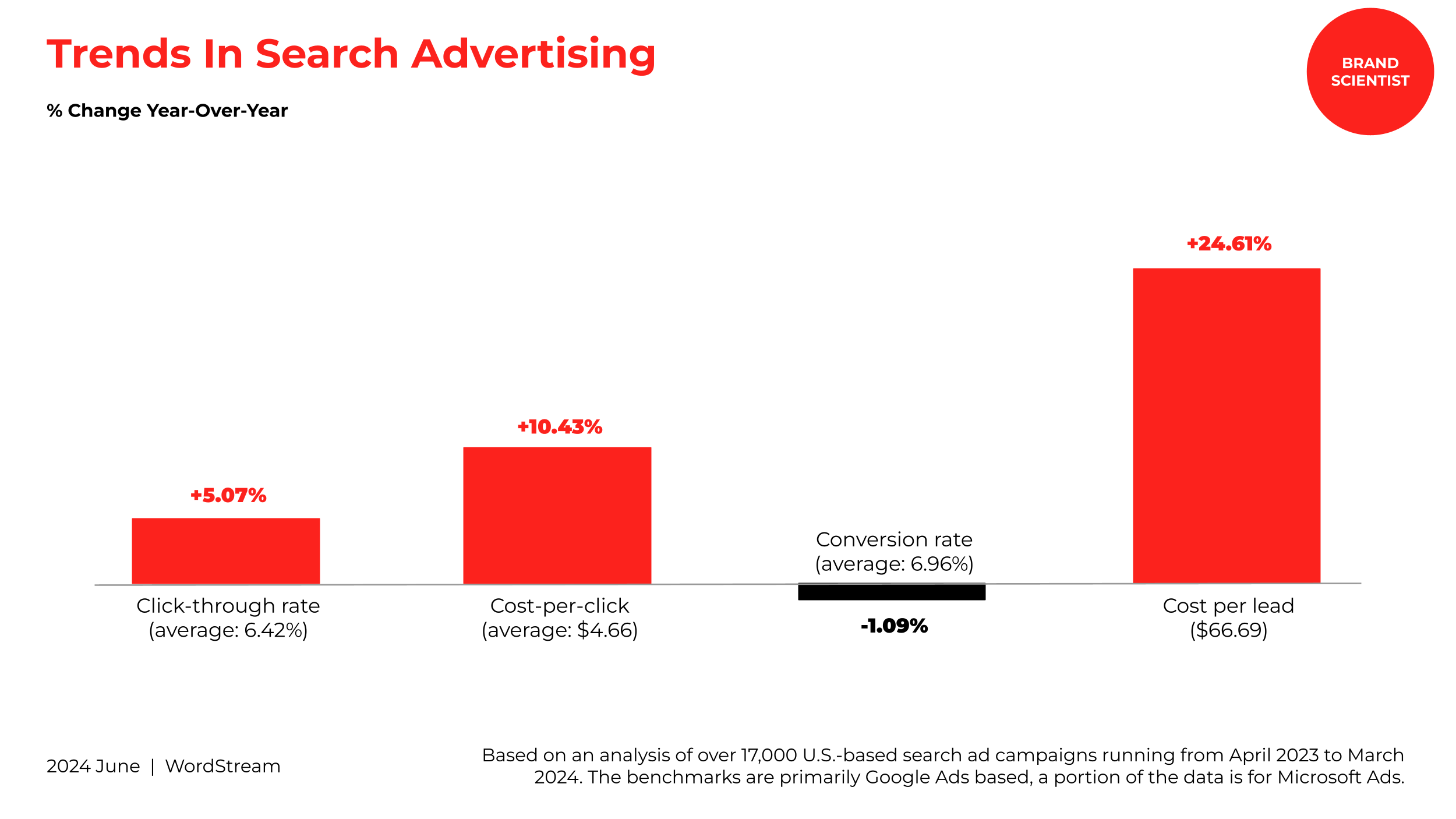CPC Have Risen, Conversion Rates Are Down, CPLs Have Skyrocketed
Paid search remains a vital channel for marketers, but its share of US digital ad spending is shrinking, according to analysis from Wordstream. Google’s recent search engine results page (SERP) changes have made it more ad-friendly, leading to higher click-through rates (CTR) but also lower conversion rates due to ads matching lower-intent searches. This shift, along with rising costs-per-click (CPC) and skyrocketing costs-per-lead (CPL), has made paid search a more challenging environment for advertisers across industries.
On average, CTR improved slightly (+5.1%) to 6.42%, with Arts & Entertainment (13.04%) and Travel (10.16%) leading in engagement. However, CPC rose by 10.43% year-over-year, averaging $4.66, with Attorneys & Legal Services ($8.94) remaining the most expensive category. The biggest CPC increase was seen in Real Estate (+35.48%), while Finance & Insurance saw the largest decrease (-25.19%). Conversion rates remained relatively stable at 6.96%, but Finance & Insurance suffered a sharp 32.4% drop, while Apparel & Fashion surged by 112%.
The most concerning trend is the dramatic rise in CPL, which jumped 24.61% to an average of $66.69. The most expensive categories included Attorneys & Legal Services ($144.03) and Furniture ($119.10), while Automotive Repair ($27.94) and Restaurants & Food ($29.67) had the lowest CPL. Despite some fluctuations in conversion rates, 19 of 23 industries saw their CPL rise, making search advertising increasingly expensive for lead generation.
With rising costs and fluctuating performance metrics, marketers must refine their paid search strategies by optimizing keyword targeting, improving landing pages, leveraging automation, and experimenting with alternative channels to maintain efficiency in their ad spend.
Key Actionable Takeaways:
Refine Keyword Strategies – Focus on high-intent keywords to counteract Google’s trend of matching ads to lower-commercial-intent searches.
Optimize Landing Pages – With conversion rates slipping, improve landing pages with clear CTAs, faster load times, and personalized content to boost conversions.
Manage Rising CPCs Carefully – Regularly review campaign budgets and adjust bids based on performance, particularly in high-cost industries like legal and home services.
Diversify Ad Spend Across Channels – Given the increasing CPL, test alternative ad platforms like Microsoft Ads, social media, and programmatic to balance costs.
Leverage AI-Powered Automation – Use Google’s AI tools for smart bidding and audience targeting to improve efficiency in ad placements.
Prioritize Retargeting Efforts – With lower conversion rates, re-engage visitors who didn’t convert initially through remarketing campaigns.
Monitor Industry-Specific Benchmarks – Regularly compare performance against industry benchmarks to adjust strategies accordingly.
Utilize Negative Keywords – Prevent wasted ad spend by excluding irrelevant or low-intent searches from targeting.
Experiment with Ad Creative and Formats – Test responsive search ads, video ads, and new ad formats to improve CTR and conversion rates.
Track Cost-Per-Lead Closely – Since CPL is rising in most industries, continuously analyze lead quality and campaign ROI to ensure profitability.
